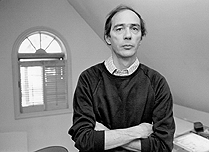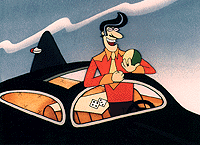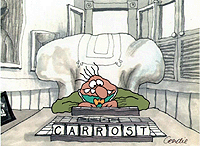The recent Siberian winter in Winnipeg may have been marrow-freezing, eyeball-aching weather, but it was also perfect animation weather. Gene Walz provides a rundown of what's been happening with the likes of Neil McInnes, Cordell Barker and Brad Caslor, among others.
Somehow Winnipeggers have once again survived a brutally Siberian winter. This one was, officially, longer, colder, and snowier than it's been in generations. Six months of snow-cover. Daily wind-chill warnings: Exposed skin freezes in 10 seconds. Almost all of January and February spent below -20.
It was marrow-freezing, eyeball-aching weather. Momma, stop chug-a-lugging the Prozac weather. Also: perfect animation weather!
Bears hibernate. Middle Americans vegetate. Winnipeggers animate. And enough of them kept their Jack Frosted noses to the peg-board this past winter to make 1996 look like it's going to be a banner year for animation. Everyone, it seems, from internationally famous Richard Condie (Getting Started, The Big Snit, The Apprentice) on down has a film nearing completion.

An Auspicious Beginning
Neil McInnes (Boarding House, Transformer) is the first Winnipeg animator to hit the screens in 1996. It's an auspicious beginning for the community. Lovehound is a send-up of a classic love story done in classic cel animation style. Ronnie the Realtor browbeats Knucklehead Pete who is smitten by the lovely Ethel, Ronnie's opportunistic mistress. Ethel spurns Pete until Pete accidentally proves his manliness. In the end, Pete gets what he wants but not quite what he expected.
If the story structure sounds familiar, it is deliberately so. After a couple of cryptic early films, McInnes wanted to "play with some dopey clichés." And play he does, to hilarious effect. Ronnie the Realtor is a nattering, manic lover whose macho posturing produces some of this movie's funniest gags, featuring exaggerated love bites and tongue kisses. Lovehound's best sequence, a tense and crazy chase edited and scored like a Hitchcock montage, ends when Ronnie's fast black car hits poor Pete's dog, and Ronnie plays hackiesack with the inert pet. Some of the humor is decidedly twisted. In fact, there is probably something here to offend everyone.

But gags and sick humor are not Lovehound's outstanding feature. McInnes has taught animation for years and it shows in the well-crafted squash and stretch animation and the beautifully designed backgrounds. He gives the movie a polished retro-look, recalling the buildings and furniture from the 1939 New York World's Fair. Most indoor scenes have an offbeat deep-focus effect achieved by placing kitschy lamps prominently in the foregrounds.
As is typical of most Winnipeg animation, this one also has a rich, multilayered soundtrack. The music, composed by Boyd MacKenzie, is thick with marimbas and flamenco guitars, as befits a Latin lover villain, but the overall effect is more like a Bernard Herman score.
Lovehound is both vulgar and sophisticated, tasteful and tasteless. It begins like Metropolis. Many of its backgrounds are postcard pretty. It's got a bad Elvis look-alike and other fifties stereotyped caricatures. Its jokes are often crude. It ends feeling like a Generation X movie. It is a refreshingly eclectic mix of pleasures.
Sweat and Agony
Paul Ulrich's new film, Love Means Never Asking You to Shave Your Legs, should have been the first Winnipeg animated movie of 1996. But a criminally incompetent courier lost his negative and sound mix. It's taken four months of sweat and agony to reconstruct things.
The story behind the movie is even more interesting. A couple of years ago the local CBC radio station ran a Valentine's Day contest. They were looking for new love songs for the nineties. Although Ulrich did not win the contest, his submitted lyrics were good enough for the CBC to set them to music, record and broadcast them. Then last year he won the Best Animation Film trophy at the Manitoba Film Awards (The Blizzards, what else?) with a crazy little film called Silence of the Clams. That was enough encouragement to convince him to animate his own song.
Love Means... is a country and western tune sung by Jim Desjarlais. Its wry three-minute story is about a woman who refuses to shave her legs and the sensitive guy who stands behind her. It should have people laughing and line-dancing in the aisles.
Several of the Winnipeg members of the Manitoba Society of Independent Animators have spent the winter doing short animated inserts for the Canadian version of Sesame Street. Although the amount of work has been scaled back somewhat in recent years, the quality remains unexpectedly high. One of the reasons is that the local animators have decided to use the children's television work as a testing ground for their own personal projects.
Bill Stewart, for instance, did two inserts of a minute or less each. In Shape Man, about circles, squares, rectangles, and triangles, he worked on more detailed character design and on acting through the animation. In 3-2-1-0, he experimented with flash frames and smoke effects like the ones in Aladdin.

Alan Pakarnyk, whose psychedelic Carried Away is featured on the NFB's video Incredible Manitoba Animation, tried his hand at computer animation for the first time. Using Swivel 3-D software on an Apple 840 AV to build his characters, he told a brief story about a man and his cat. Bob lifts the cat up; when the cat objects, he puts it back down. Not so simple Up and Down.
Anita Lebeau took time out from her own eight-minute animated film, Louise, to work on two Sesame inserts. The Letter S is an exercise in wit, characterization and timing. In it a spider sews a sweater for a skunk shivering in a snowstorm. Twelve Flies is a simple lesson complicated by the fact that it was two minutes long and filmed without cuts.
Jason Doll used the Sesame commission to test out color, line, and characterization for his upcoming film Santa's Gotta Gun. This film is definitely not for kids. In it, a thug busts out of jail, kills a Salvation Army Santa, and then hides out in a men's room. A child almost as persistent as the feline nemesis in Cordell Barker's The Cat Came Back has to be dealt with in increasingly violent and amusing ways.
Santa's Gotta Gun and Louise may need another horrible Winnipeg winter to bring them to completion. Likewise, the much-anticipated projects by two of the city's premier animators: Oscar-nominee Cordell Barker and Genie-winner Brad Caslor.
After a back ailment caused him serious delays on his project On TV, Caslor has a new storyboard and is building momentum again. This darkly humorous examination of the effects of the tube on people's behavior promises an entirely new look for Caslor's work. Unlike the marvelous pastiche of forties cel animation (especially Bob Clampett) that made Get a Job such a sensation, this one will be done entirely on paper with black and colored pencil drawings.
Barker has expanded his original nine-minute film Strange Invaders into a 22 minute opus. It's about a thirtysomething couple who question whether they should start a family. In the middle of the night a strange child is delivered to them, and it is not exactly an answer to their prayers.
Strange Invaders will have a hokey 1950s sci-fi look to it, along the lines of Invaders from Mars and The Thing. It's hard to predict when it will be ready, as Barker keeps getting tempted away by commercial work. Most recently, he has animated a series of television ads for the phone company of Quebec. Unfortunately, you have to live there to see any of his work lately.
Doing New Things
Winnipeg's other celebrity animator, Richard Condie, has been squirreled away for the past several years in his workroom on the second floor of his River Heights bungalow. He has been assiduously mastering the intricacies of computer animation. He attributes his decision to try the computer to "Thaddeus Toad syndrome." Like the Toad in the Hole in The Wind in the Willows, he must do new things. The resulting new film, La Salla, will be released this summer.
La Salla is well worth the wait, but Condie is not entirely sure about the Herculean effort. There were disconcerting surprises at every turn and frustrations galore. The original machine he was using developed 32 different hardware failures before he tossed it out. When he finally got comfortable with the replacement (a Silicon Graphics Indigo Extreme with a 2 gigabyte hard drive and 256 megs of RAM), he realized that "the choices can drive you nuts!"

The Softimage 3-D (version 3.0) software made discipline paramount. "If you had a permanent income, you could go off somewhere and play with it for an entire lifetime and still not exhaust the possibilities," he marveled. The wave effect, for instance, which the company included to animate flags, could be used, Condie discovered, for solids as well. So he used it to animate the firing of a cannon.
The cannon is only one weapon in the weird arsenal of comic effects in La Salla. Turn on the laugh meter for this one!
The story is simple. A Condie-boy (unnamed in the movie but called "Adam" in the script) plays with his toys and is tempted by the door leading out of his room.That's not everything, but it's enough. For the story is really in the toys and the way Adam plays with them. Among other things, there's a mechanical fish, a peculiar three-dimensional Etch-a-sketch plus TV thing, and the aforementioned cannon which shoots out cows instead of cannon balls.
Much of the inspired zaniness that Condie is renowned for comes from bizarre distortions of the familiar and an exaggerated soundtrack. There are the usual gurgles and gasps and anguished howls here, but the real treat comes from Condie's return to his first love--music. (He has composed music for other people's films.) La Salla is not spoken; it is sung. And I don't think it's giving away too much to provide one of the film's best recitative lines: "Moments ago I had everything. Now there's a cow in my nose."
Condie describes La Salla as a combination of Genesis-2 and Paradise Lost. (When was the last time you heard a filmmaker put those two sensibilities together?!) He's being modest, of course, and he should toss in Toy Story and Saturday Night Live's Opera Man. And up the comic ante by a lot.This is everything you'd ever want in a Richard Condie film and more. It's a computer-animated Richard Condie film. The jokes, characters and props are the same, but this is a staged performance rather than a series of drawings. Which means Condie gets to play with the camera and the lighting and the props. All this makes for a darker, more cluttered image than is his won't, and it probably underlines the seriousness of the endeavor and the message as well. Luckily, it does not diminish his signature zany humor.
Condie's films have always been true auteur films. Perhaps more so than any other animator he puts his own experiences in his work. There's no mistaking that the piano player in Getting Started is the filmmaker himself. La Salla is another one of these personal parables. The boy playing with his toys is not so terribly far away from the artist playing at his computer. (And thank the Lord for that!) Stuck in his room and trying to laugh and make the best of it. Parody and paranoia.
This is Condie's special territory, but it is not entirely unique to him. Cabin-fever animation. It's what a lot of Winnipeggers do.
Gene Walz is head of the film program at the University of Manitoba, Winnipeg. He is currently finishing a biography on character designer Charlie Thorson and is now editing a book called Great Canadian Films.







